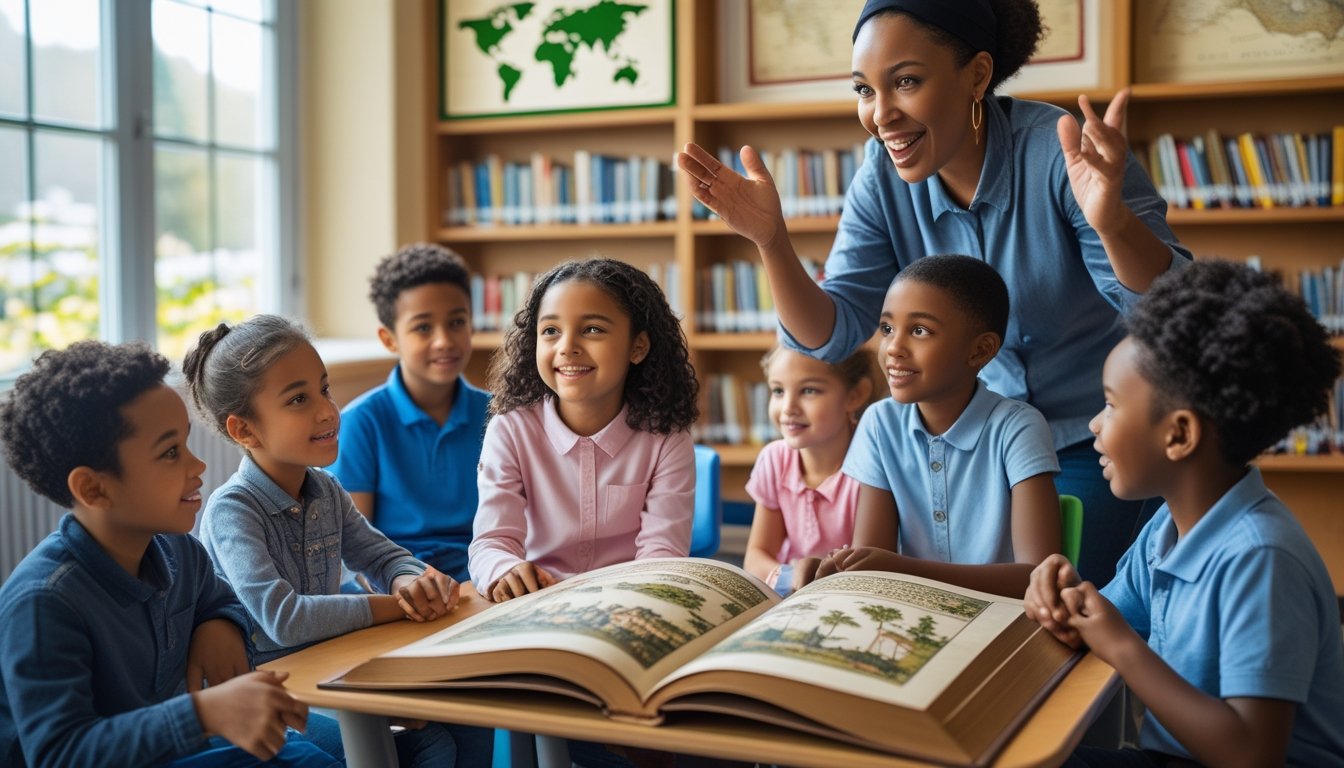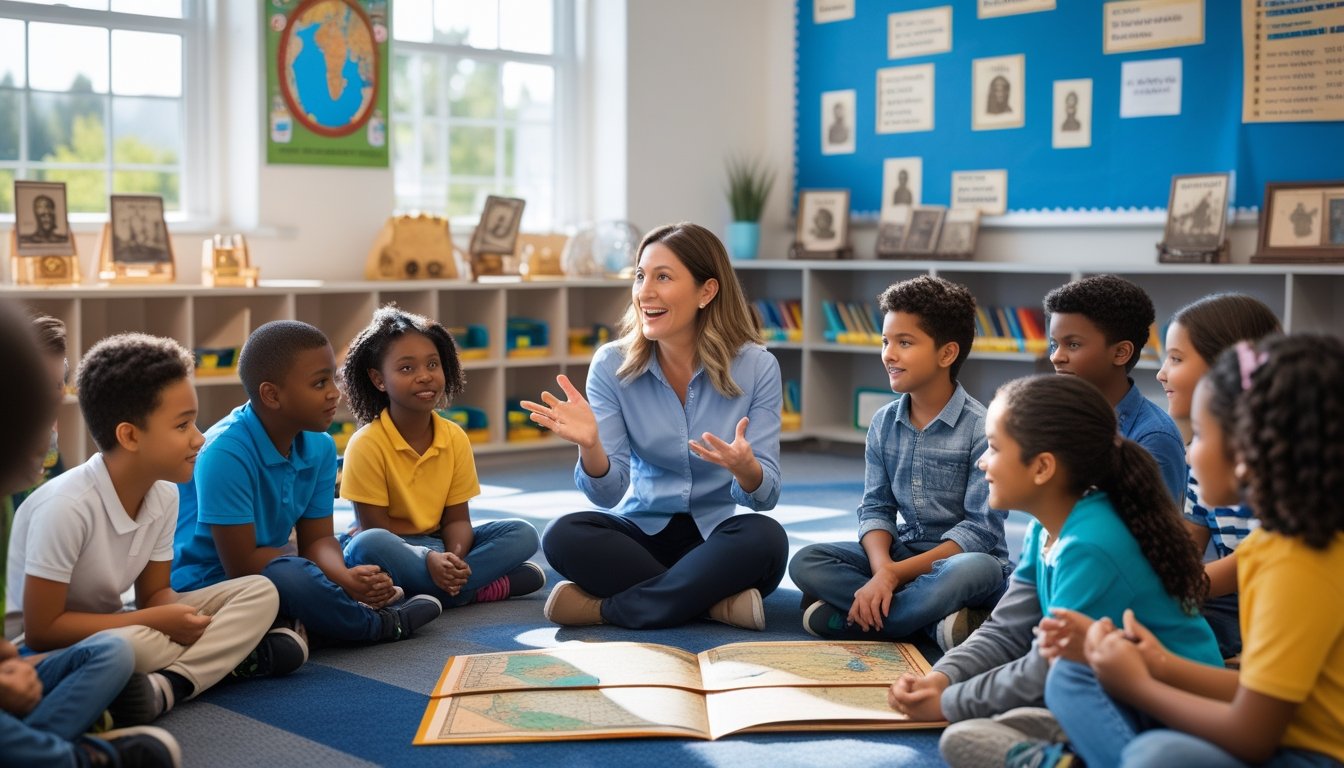Late updated: 04 Jun 2025 08:06
Written by:
Engaging Children With Historical Storytelling: Techniques for Captivating Young Minds
Engaging children with history can seem like a daunting task in the digital age, yet the art of storytelling remains a powerful tool. By weaving historical events into captivating narratives, we provide a window into the past that can spark curiosity and connection. Through stories, children can connect with prominent figures and pivotal moments, bringing history to life in their imagination.

Historical storytelling offers children a unique way to see themselves in the broader context of the world. It fosters a sense of identity and belonging by linking personal experiences to the grand tapestry of history. By encouraging children to participate in storytelling, they not only enhance their comprehension but also develop critical communication skills.
Incorporating multimedia elements such as videos and animations can further enhance this learning experience, making it more relatable and enjoyable. These tools, combined with traditional storytelling, can transform the learning of history into an engaging adventure for young minds.
Key Takeaways
- Storytelling connects children to history in meaningful ways.
- Historical narratives help develop children's identity and communication skills.
- Multimedia elements can enrich the historical storytelling experience.
The Importance Of Historical Storytelling For Children
Historical storytelling serves as an invaluable tool for children, enriching their understanding of history and encouraging critical thinking. It fosters a deeper connection to the past while supporting the development of essential skills.
Benefits Of Storytelling In Education
Historical stories captivate young minds, enhancing their learning experiences. For children, these narratives are more than just tales—they are educational journeys. Through engaging stories, students gain insights into different cultures and historical periods, promoting an understanding that transcends textbooks. Storytelling fosters comprehension and vocabulary, providing context that helps children remember historical facts better. By introducing complex ideas in an accessible manner, storytelling shapes students’ ability to critically evaluate historical events, making education an interactive process.
Connecting History With Young Learners
Bridging the gap between past and present is crucial when teaching history. Historical storytelling transforms abstract dates and events into relatable narratives. Young learners can see history's impact on their lives, making lessons more meaningful. Through engaging stories, we ensure children grasp historical significance and context. This connection nurtures a lifelong interest in the past and builds a solid foundation for future history education. By weaving storytelling into history lessons, educators can effectively capture and hold students' attention, sparking curiosity and promoting exploration.
Nurturing Imagination And Self-Esteem Through Historical Stories
Historical stories not only educate but also inspire imagination and boost self-esteem. Tales of past explorers, inventors, and leaders encourage children to envision new possibilities for themselves. Imagining oneself in historical contexts offers valuable perspectives on capabilities and achievements. As children see figures overcoming challenges, their confidence grows. By relating to characters who faced trials and emerged victorious, children can develop resilience and self-worth. Historical storytelling thus becomes a powerful tool, motivating young minds to dream and believe in their potential.
Effective Approaches To Engaging Children With Historical Storytelling

Engaging children with history through storytelling involves using personal narratives, interactive experiences, and immersive educational tools. This helps connect them with the past, building understanding and empathy.
Utilising Family Stories And Personal Narratives
Family stories and personal narratives can bring history to life in a way that resonates deeply with children. By sharing tales from our own ancestors, we create an emotional connection, making historical events more relatable.
For instance, recounting a grandparent’s experiences during wartime not only offers insight into personal courage and resilience but also provides a sense of where we come from. This approach fosters a deeper connection to history, encouraging children to appreciate diverse perspectives.
Engaging with such narratives builds confidence and acceptance as children learn about their heritage and the broader historical context.
Incorporating Artifacts, Photos, And Exhibitions
Viewing artifacts and photos offers tangible windows into the past. Museums and exhibitions play a crucial role in presenting these physical pieces of history. By examining these items, children can better visualise and connect with historical events.
Artifacts such as old uniforms, tools, or letters tell stories of the people who used them. Photos capture moments in time, allowing us to explore how our ancestors lived and worked.
Incorporating these tangible elements into storytelling enriches learning and sparks curiosity, prompting questions and discussions that deepen historical understanding.
Interactive Techniques: Role-Playing And Performances
Interactive techniques like role-playing and performances enable children to step into historical figures' shoes. Through these methods, children actively engage with historical narratives, enhancing their understanding and retention.
Role-playing activities might involve students acting out historical events or engaging in Civil War reenactments. Such performances allow children to explore different perspectives and consider the motivations behind historical actions.
Participation in these activities cultivates interest and enthusiasm, linking education with creative exploration. Engaging children this way promotes critical thinking and emotional connection, bridging the gap between past and present.
Integrating Historical Storytelling Within School Curriculum
Integrating historical storytelling within the school curriculum ensures that children continually engage with history throughout their education. By weaving stories into lessons, we bring historical events to life in a dynamic way.
Teachers can include storytelling elements in subjects like history and literature, using narratives to illustrate key concepts. This might involve examining primary sources, encouraging students to reconstruct historical events.
By connecting storytelling with academic interests, such as sports or medicine, teachers make history relevant to students' lives. Encouraging children to discover personal connections with historical topics fosters a lifelong interest in learning and exploration.
Frequently Asked Questions

Engaging children with historical storytelling involves using interactive methods to evoke curiosity and appreciation for history. We explore various strategies to engage young learners, assess their grasp of history, and foster critical thinking.
How can historical storytelling activities captivate the interest of young minds?
By incorporating interactive storytelling, we create an immersive experience that captures children’s imaginations. This can be achieved through role-playing, creative dramatics, and using vivid narratives that allow children to envision historical events and figures in a relatable context.
What strategies are effective for making history lessons more engaging?
Involving children actively in the learning process is key. Using primary sources, integrating multimedia resources, and setting up story-driven simulations make history tangible. Encouraging children to express their views and create their own narratives based on historical facts adds personal involvement and enhances engagement.
How can we assess high school students' understanding of historical figures?
We can use projects, presentations, and discussions that require students to delve into the lives and impacts of historical figures. Assignments could include creating biographies or conducting debates representing the figures’ perspectives. These assessments help in evaluating how well students internalise historical contexts and influence.
What is the significance of using storytelling to teach history to children?
Storytelling provides context and continuity, making abstract historical events more accessible and memorable. By framing history as a series of compelling narratives, we help children identify with the experiences of people from the past. This approach fosters empathy, understanding, and a deeper connection to historical content.
Which skills encourage children to think critically about history?
Facilitating inquiry-based learning encourages critical thinking. Skills such as questioning assumptions, analysing sources for bias, and comparing differing accounts build a reflective approach to history. Critical thinking is further developed by engaging children in discussions where they justify their viewpoints with evidence.
Can you provide an illustrative example of storytelling that brings historical events to life for students?
Imagine a classroom transformed into a medieval marketplace. Students take on roles as merchants, peasants, or nobility, experiencing the social dynamics and economic systems of that era. Through this role-play, students explore the complexities of medieval life, gaining a nuanced understanding of historical themes and contexts.
